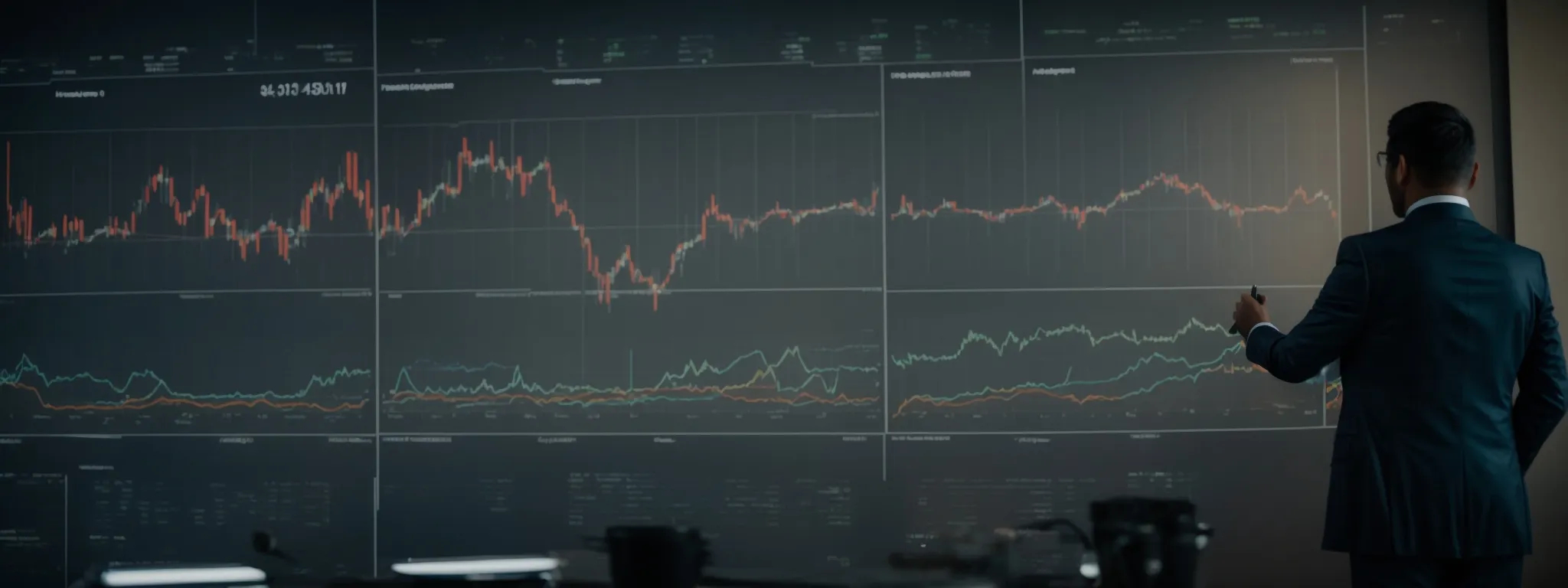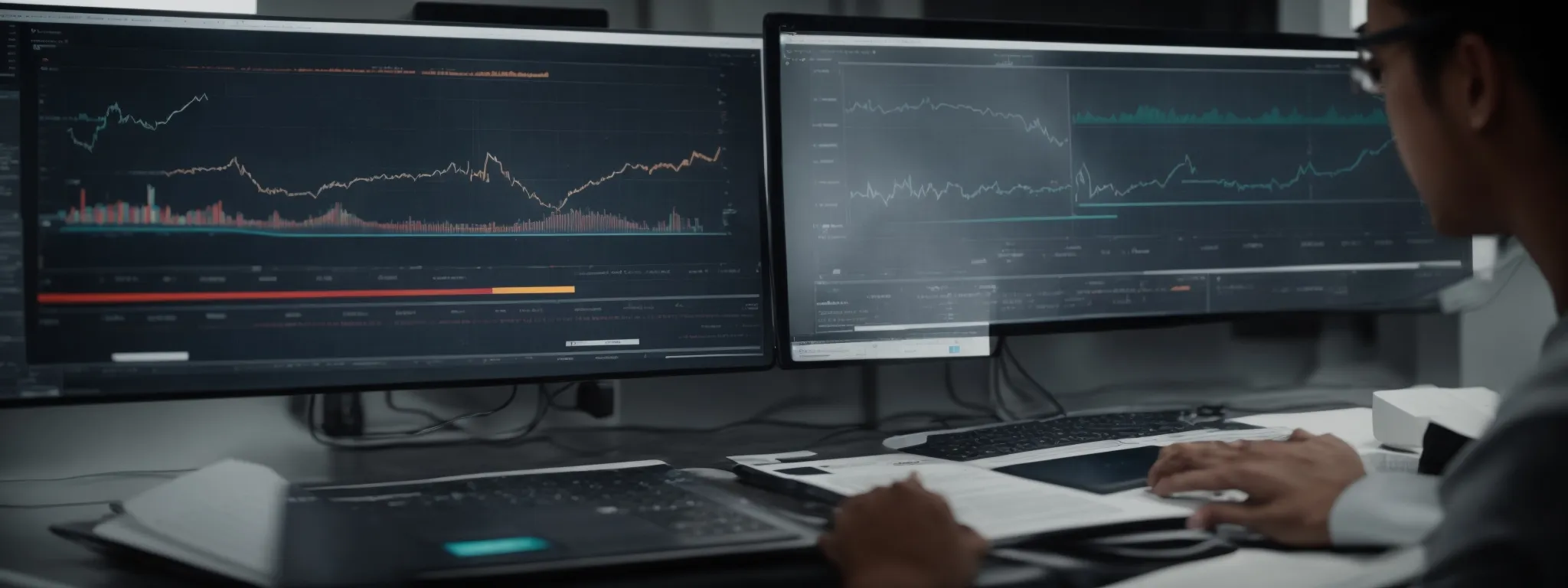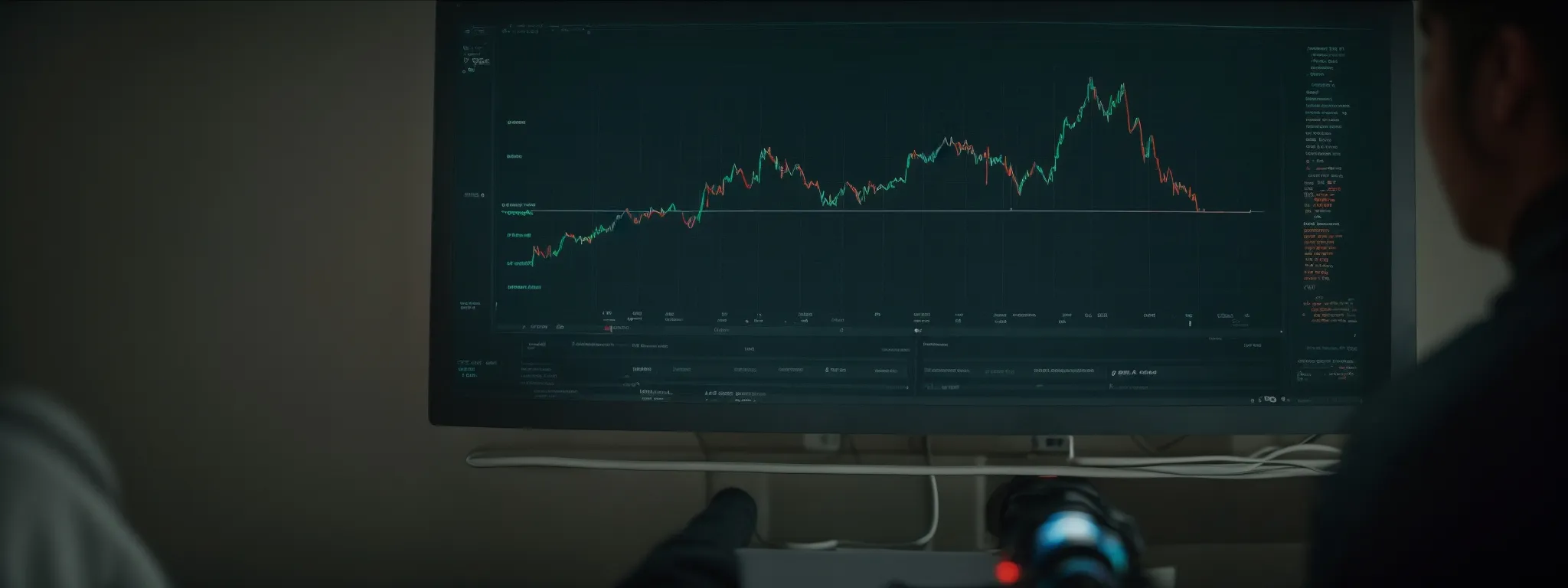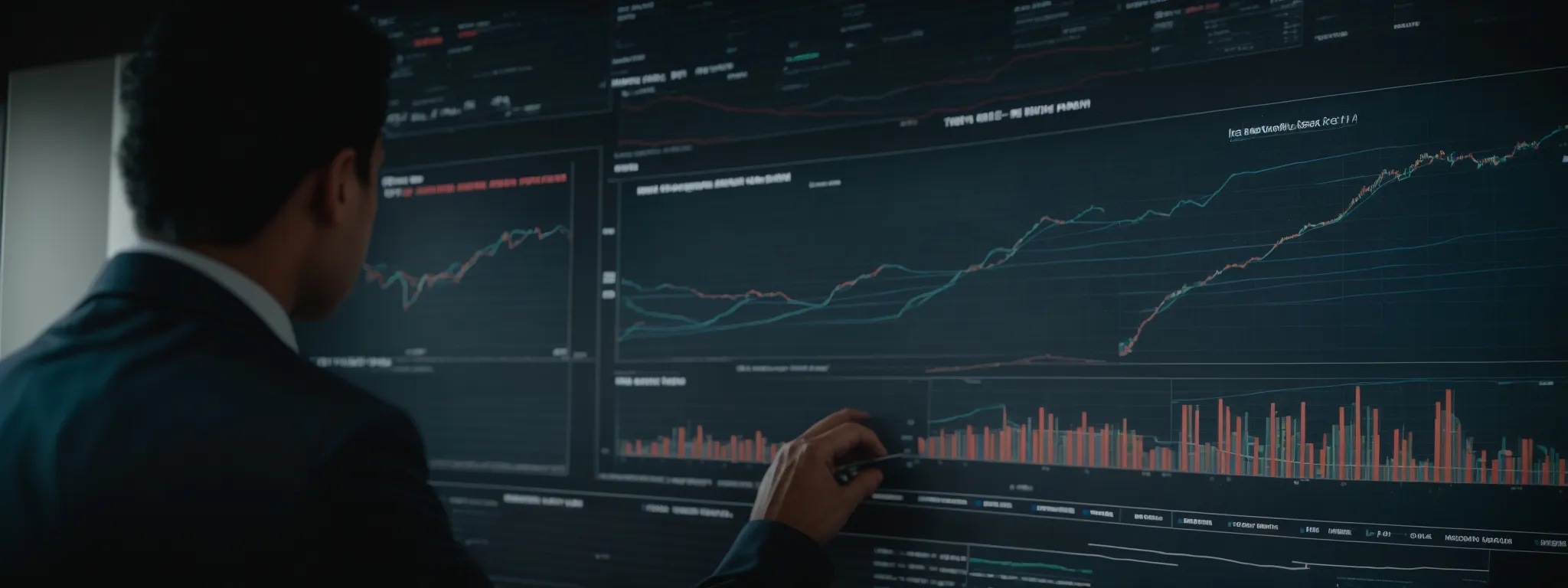ROI Metrics in Digital Marketing
Understanding ROI Metrics in Digital Marketing In the swiftly evolving landscape of digital marketing, the quest to quantify success hinges on understanding and leveraging Return on Investment […]
Understanding ROI Metrics in Digital Marketing
In the swiftly evolving landscape of digital marketing, the quest to quantify success hinges on understanding and leveraging Return on Investment (ROI) metrics.
Marketers invest considerable effort in campaigns spanning from social media to email marketing, and tracking the financial returns on these investments is critical for business growth and strategy refinement.
Accurate ROI calculations empower organizations to steer their marketing budgets effectively, ensuring that each dollar spent is an investment toward measurable revenue growth.
Fine-tuning marketing strategies through diligent ROI analysis can significantly elevate a company’s digital presence and profitability.
In this article, readers will discover the pivotal ROI metrics that are fundamental to mastering the art of digital marketing efficiency.
Key Takeaways
- Accurate ROI Calculation Is Essential for Determining the Effectiveness of Digital Marketing Strategies
- LinkGraph’s SearchAtlas SEO Software Aids in Tracking and Analyzing Key Metrics for ROI Analysis
- Cost Per Lead Reduction Strategies Like Enhanced Targeting and Content Optimization Can Increase ROI
- CRM Systems and Marketing Automation Are Vital for Tracking Customer Interactions and Measuring ROI Accurately
- Setting Realistic ROI Goals Requires Understanding Industry Benchmarks and Leveraging Historical Data
Exploring the Basics of ROI in Digital Marketing

In the realm of digital marketing, the ability to distill the efficacy of marketing endeavors into clear, quantitative data is critical for businesses aiming to optimize their online presence and allocate budgets effectively.
Return On Investment (ROI), a vital performance metric, serves as a compass for marketing managers, guiding the strategic planning and execution of digital campaigns.
Understanding ROI within this context is paramount as it provides insight into the relation between marketing spend and profit generated.
With a focus on defining ROI in the digital landscape, this introduction addresses its significance in assessing the health of digital marketing efforts and outlines foundational principles for its precise computation.
Businesses must grasp these concepts to craft strategies that not only captivate audiences but also bolster the bottom line.
Defining ROI Within the Digital Marketing Context
Return on Investment (ROI) in digital marketing translates to a gauge of financial performance that compares the net profit to the initial marketing investment. It embodies the profitability derived from marketing actions, enabling organizations to discern which strategies foster revenue growth and which may require reevaluation.
ROI illuminates the effectiveness of digital marketing campaigns, offering insights into customer acquisition cost relative to customer lifetime value (CLV). By quantifying the success ratio, businesses develop a profound understanding of the marketing tactics that yield high returns, crucial for informed decision-making and strategic adjustments.
| Marketing Metric | Explanation | Relevance to ROI |
|---|---|---|
| Marketing Investment | Total cost spent on marketing efforts | Baseline for calculating ROI |
| Customer Acquisition Cost (CAC) | Expense of acquiring a new customer | Lower CAC indicates a higher ROI potential |
| Customer Lifetime Value (CLV) | Projected revenue from a customer over time | Greater CLV suggests an elevated ROI |
The Importance of Measuring ROI for Digital Campaigns
Measuring ROI is essential for optimizing digital marketing strategies, as it empowers companies to identify the most cost-effective methods for reaching their target audience. By evaluating the return on every dollar spent, digital marketing becomes not just an art but an analytical science, driving financial accountability for marketing budgets.
Crafting successful digital marketing campaigns hinges on a thorough understanding of ROI metrics, which shape an organization’s decisions about where and how to invest its marketing dollars for maximum impact:
- Analyze marketing cost versus profits to determine the true effectiveness of each campaign.
- Adjust marketing tactics in real-time based on data-driven insights to improve ROI.
- Allocate resources efficiently by directing funds to the most lucrative marketing channels.
Key Principles for Accurate ROI Calculation
To achieve precision in ROI calculations for digital marketing, attention to detail is key. It begins with the accurate tracking of all marketing expenditures, from PPC Google Ads to the subtle costs embedded in digital PR services. Integrating platforms like SearchAtlas SEO software can enhance this process by providing advanced data points and analytics necessary for comprehensive financial analysis.
Another critical principle lies in correctly attributing sales revenue to the specific marketing initiative. Modern digital marketing solutions, like those offered by LinkGraph, enable marketers to trace conversion paths using UTM parameters, ensuring that every customer touchpoint is accounted for in measuring the direct impact on the organization’s bottom line.
Essential ROI Metrics Every Marketer Should Track

Within the tapestry of digital marketing, meticulous attention to ROI metrics is non-negotiable for discerning marketers.
The journey to ROI mastery entails unraveling the nuances of Conversion Rate and its substantial sway over marketing success, scrutinizing the pivotal role of Customer Acquisition Cost in financial forethought, appreciating the long-term significance of Customer Lifetime Value, and recognizing the influence that Average Order Value exerts on overall ROI achievements.
As these metrics interweave, they form a robust framework for evaluating the financial fruits of digital marketing endeavors, ultimately guiding businesses in fine-tuning their strategies for optimal market impact and profitability.
Breaking Down Conversion Rate and Its Impact on ROI
The conversion rate stands as a critical indicator of a digital marketing campaign’s success, reflecting the percentage of users who take a desired action on a website or landing page. This metric directly impacts ROI, as a higher conversion rate typically signals more efficient use of marketing resources, leading to increased revenue relative to the cost of customer engagement and acquisition.
Marketing professionals focus on optimizing conversion rates to boost overall ROI, ensuring that user visits are not mere vanity metrics but genuine opportunities for conversion. Effective strategies that elevate conversion rates, supported by tools such as LinkGraph’s SEO Content Assistant, directly correlate with a healthier return on investment, thus affirming the integral role of conversion rate in the calculus of digital marketing success.
The Role of Customer Acquisition Cost in ROI Analysis
The assessment of Customer Acquisition Cost (CAC) is indispensable within ROI analysis, as it directly reflects the capital expended to gain a new customer. This crucial performance indicator assists in gauging the economy and effectiveness of marketing efforts, crucial for steering a company’s strategy towards cost-efficient practices and greater profitability.
By minimizing CAC, businesses enhance their ROI, since a lower investment to acquire customers naturally boosts the return from marketing initiatives. Marketing professionals utilize this metric as a beacon to optimize their campaigns, guiding them in crafting targeted efforts that convert prospects into customers without excessive expenditure.
Understanding Customer Lifetime Value as an ROI Metric
Grasping the concept of Customer Lifetime Value (CLV) yields profound insights into the long-term profitability of a company’s relationship with its customers. It is the projection of revenue a business can expect from a customer over the entirety of their relationship, serving as a critical metric in evaluating the return on marketing investments and guiding budget allocation towards fostering higher-value customer segments.
Marketing specialists employ CLV as an indispensable benchmark in ROI analysis to ensure marketing strategies are aligned with sustained revenue generation rather than short-term gains. This emphasis on lifetime value rather than immediate returns anchors marketing decisions in the pursuit of enduring growth and customer engagement, aligning digital marketing efforts with the overarching financial objectives of the organization.
Why Average Order Value Influences ROI Success
Regarding the calculus of digital marketing ROI, Average Order Value (AOV) emerges as a crucial factor in determining the success of marketing initiatives. This metric indicates the typical revenue generated from each customer transaction, providing insights into consumer behavior and spending patterns.
Uplifting AOV directly correlates with an increase in ROI, as it signifies that marketing strategies are successfully enticing consumers to purchase more during each visit. By focusing on strategies that encourage higher-value sales, companies can leverage AOV as a lever to enhance overall profitability and return on marketing investment.
| ROI Metric | Description | Impact on ROI |
|---|---|---|
| Average Order Value (AOV) | Mean revenue earned per customer transaction | Higher AOV boosts ROI by elevating revenue from sales |
Calculating ROI From Different Marketing Channels

As businesses venture through the varied terrains of digital channels, measuring the return on investment (ROI) from each path taken becomes a quest for clarity and profitability.
Whether maneuvering through the intricate web of organic search initiatives, engaging audiences via social media platforms, fine-tuning the reach of email marketing, or allocating funds for paid advertising campaigns, the ability to gauge the financial impact of these diverse marketing channels stands as a cornerstone of a robust digital marketing strategy.
This evaluation provides a panoramic view of the marketing landscape, ensuring that resources are judiciously invested, and strategies are molded to maximize ROI—a crucial step in orchestrating a symphony of successful digital marketing activities.
Assessing ROI for Organic Search Initiatives
Organic search remains a cornerstone in assessing digital marketing ROI, with its cost-effective nature allowing for an insightful evaluation of long-term profitability. Calculating ROI for organic search initiatives requires monitoring increases in website traffic, improvements in search engine ranking, and the quality of user engagement generated through search engine optimization (SEO) efforts.
To accurately measure the ROI of organic search strategies, LinkGraph’s suite of digital marketing solutions proves instrumental. The Sophisticated Analytics Delivered by SearchAtlas SEO Software, for instance, arm marketing professionals with the necessary tools to track progress and discern the tangible impact of organic search on overall marketing effectiveness and revenue growth.
- Track organic traffic growth to identify successful SEO efforts.
- Analyze search rankings to gauge visibility in search engine results pages.
- Evaluate user engagement metrics to assess the quality of organic traffic.
Evaluating Social Media Marketing Through ROI Lens
Assessing the return on investment of social media marketing campaigns is an intricate task, deeply rooted in the ability to discern between superficial and meaningful audience interactions. Marketers leverage engagement rate and conversion data to quantify the influence of social media endeavors on the company’s revenue streams.
Given the multifaceted nature of social platforms, measuring social media ROI requires a granular analysis of campaigns, focusing on both direct sales conversions and the broader, more diffuse benefits, like brand exposure and customer loyalty. Tools Such as the SearchAtlas SEO Software’s Social Analytics can offer deep insights into how social media investments translate into tangible business outcomes.
| Social Media ROI Metric | Method of Measurement | Relevance to ROI |
|---|---|---|
| Engagement Rate | Assessment of likes, comments, and shares relative to audience size | Reflects audience’s interest and potential for conversion |
| Conversion Rate | Tracking the percentage of engaged users completing a purchase | Directly ties social interactions to revenue generation |
The Importance of Email Marketing ROI Optimization
In the digital marketplace, email campaigns remain a potent vehicle for personal, direct communication with consumers, rendering email marketing ROI optimization a crucial aspect of overall digital marketing strategy. Effective optimization of email marketing ROI ensures that every email sent contributes positively to the broader objectives of the campaign, enhancing customer engagement and driving conversions.
Through precise segmentation and personalization tactics, marketing teams can optimize the relevance of their messaging, bolstering open and click-through rates while monitoring the conversion rate to weigh the profitability of email marketing channels. The resultant metrics play a key role in refining digital marketing efforts, tailoring future communications to resonate even more deeply with the intended audience:
| Email Marketing Metric | Impact on Digital Marketing Strategy |
|---|---|
| Open Rate | Indicates the effectiveness of email subject lines and the degree of audience engagement |
| Click-Through Rate (CTR) | Reflects the appeal of email content and its success at prompting a designated action from the reader |
| Conversion Rate | Measures the ability of email campaigns to convert recipients into customers, directly influencing ROI |
Paid Advertising and Its Contribution to Overall ROI
Paid advertising’s influence on digital marketing ROI is profound and multifaceted, driving immediate results through targeted outreach. When campaigns are meticulously designed and managed, Pay-Per-Click (PPC) Google Ads and Amazon PPC ads can generate significant returns by reaching customers at critical points within the marketing funnel.
This form of digital marketing not only increases visibility but, when executed with precision, can lead to a favorable balance between expenditure and revenue generation. The contribution of paid advertising to overall ROI hinges on the ability to optimize ad spend while maximizing conversion rates and customer acquisition:
- Monitor and adjust CPC and CTR to ensure efficient use of PPC budgets.
- Leverage analytics tools to identify the most profitable ad placements and target demographics.
- Measure the impact of ad creative and messaging on consumer behavior and sales conversion.
ROI Tools and Technologies for Effective Tracking

In the dynamic sphere of digital marketing, the deployment of sophisticated tools and technologies is indispensable for piercing through the veil of data to access actionable ROI insights.
Enlightened marketing managers harness the power of analytics platforms to extract the essence of vast datasets, interpret intricate consumer behaviors, and track the effectiveness of marketing campaigns with precision.
The strategic integration of automation in marketing efforts streamlines the measurement of ROI, while Customer Relationship Management (CRM) systems offer a vantage point from which the full spectrum of customer interactions and their impact on ROI can be viewed.
With these advanced resources at their disposal, organizations can augment their comprehension of ROI, enabling them to refine and personalize their marketing strategies for an audience that is perpetually evolving.
Leveraging Analytics Platforms for ROI Insights
Analytics platforms stand at the forefront of the digital marketing landscape, offering invaluable ROI insights that drive strategic decision-making. These tools enable marketing professionals to track performance metrics such as engagement rate, conversion rate, and customer retention rate, providing a clear picture of a campaign’s financial efficiency and areas for potential improvement.
Through the precise data aggregation and reporting capabilities of analytics platforms like SearchAtlas SEO software, organizations gain the ability to dissect complex marketing data. This empowers them to pinpoint the efficacy of each marketing channel, informing adjustments that enhance ROI and ensuring that marketing spend translates into tangible business growth.
Using Marketing Automation to Improve ROI Measurement
Marketing automation emerges as a revolutionary asset in fine-tuning the measurement of ROI in digital marketing. By providing a systemic approach to scheduling campaigns, tracking consumer responses, and analyzing online behavior, these technologies enable an unprecedented level of precision in calculating returns on marketing investments.
With marketing automation, professionals can effortlessly segment audiences, personalize messaging, and trigger communications based on user actions, ensuring a strategic deployment of marketing efforts that drive meaningful business results. This streamlined process allows marketers to focus on creative and strategic tasks while algorithms handle the data-driven aspect of ROI tracking.
How CRM Systems Can Enhance ROI Understanding
Customer Relationship Management (CRM) systems have become integral in deciphering the myriad facets of ROI in digital marketing. These systems consolidate customer interactions across various touchpoints, granting companies a holistic view of the customer journey and enabling a nuanced understanding of which marketing initiatives are driving profitable engagement and loyalty.
By serving as a synergy of data collection and analysis, CRM platforms provide a centralized repository of customer information that is crucial for calculating accurate marketing ROI. This alignment of customer data with marketing campaigns allows organizations to streamline their efforts, personalize their consumer interactions, and ultimately amplify their return on marketing investments.
Maximizing ROI With Conversion Rate Optimization

In the pursuit of fortifying digital marketing strategies, a keen focus on conversion rate optimization can empower marketing managers to enhance the return on investment (ROI) for their online campaigns.
Optimization begins with the meticulous analysis of conversion funnels to isolate stages that hinder customer progression, followed by utilizing A/B testing methodologies for strategic refinements, and implementing user experience modifications aimed at amplifying engagement and conversions.
This multifaceted approach to optimization is pivotal in transforming potential customer interactions into measurable success, ultimately elevating the effectiveness and ROI of digital marketing efforts.
Identifying Weak Points in the Conversion Funnel
Pinpointing the frail segments of a conversion funnel is a penetration into the crux of digital marketing efficacy. This scrutiny requires the discernment of the conversion process at granular levels where user dropout is prevalent, whether it’s on a preliminary landing page or at the checkout phase where the commitment to purchase clinches.
Experts at LinkGraph, equipped with the SEO Content Assistant, are adept at discerning and interpreting user behavior data to uncover these critical junctures. Their analytical prowess allows them to detect bottlenecks and subsequently harness this knowledge to streamline the user journey, thus bolstering conversion rates and enhancing overall marketing ROI.
A/B Testing Strategies for ROI Improvement
A/B testing stands as an essential strategy for enhancing ROI, allowing marketers to make data-driven decisions by comparing two versions of a web page or campaign element against each other. This process hinges on exposing different groups to variant A or B, then analyzing the results to determine which version leads to better conversion rates, ultimately leading to improved return on investment.
By systematically implementing A/B testing, marketing teams at digital marketing agencies like LinkGraph gain the ability to refine landing pages, email campaigns, and other digital assets. Such precision adjustments, informed by user interaction and conversion data, fine-tune the user experience and lead to significant uplifts in ROI, reflecting a sophisticated approach to online marketing strategy.
User Experience Tweaks That Boost ROI
Delving into the realm of digital marketing, one finds that the refinement of user experience is a powerful lever for amplifying return on investment. Intuitive navigation, streamlined checkout processes, and responsive design are examples of user experience improvements that can lead to a noticeable increase in conversion rates, thus boosting a campaign’s ROI.
In the tireless quest to optimize digital performance, the application of user-centric designs that facilitate ease of information access and simplify user interactions has proven to significantly uplift ROI. The incorporation of these user experience tweaks, mindful of the customers’ needs and preferences, can yield a more engaging digital environment that encourages conversion and cultivates customer loyalty.
The Role of Cost Per Lead in ROI Determination

In the dynamic landscape of digital marketing, the concept of Cost Per Lead (CPL) emerges as a pivotal performance metric, intricately tied to the calculation of Return On Investment (ROI).
CPL captures the expense entailed in generating a prospective customer—a cogent data set that informs businesses on the efficiency of lead generation strategies.
Delving into methods for reducing CPL, marketers seek avenues not only to economize but also to ensure that lead quality is not compromised in the quest for quantity.
It becomes a strategic balancing act, requiring discernment and precision to fine-tune marketing tactics that drive a wholesome enhancement of ROI.
Methods for Reducing Cost Per Lead
Reducing Cost Per Lead (CPL) begins with enhancing the precision of targeting in digital marketing campaigns: by focusing on high-quality leads rather than sheer volume, organizations can decrease extraneous spending and drive a higher ROI. By employing advanced targeting methods, such as those facilitated by SearchAtlas SEO software, companies can ensure that marketing resources are concentrated on the most receptive and valuable segments of their target market.
| CPL Reduction Strategy | Description | Expected Impact |
|---|---|---|
| Enhanced Targeting | Employing data-driven targeting to refine audience segments | A more efficient allocation of marketing resources, leading to a lower CPL |
| Content Optimization | Creating relevant, engaging content that resonates with the target audience | Improved conversion rates and a more cost-effective lead acquisition |
Another effective method to lower CPL is the optimization of marketing content to bolster engagement and conversions. When organizations align their messaging with the interests and demands of their target audience, they enhance the likelihood of converting prospects into leads. Utilizing LinkGraph’s SEO Content Assistant allows companies to create content that is not only engaging but also SEO-friendly, thereby attracting more qualified leads and diminishing the overall cost per acquisition.
Balancing Lead Quality and Quantity for Optimal ROI
Securing an optimal ROI demands a delicate balance between lead quality and quantity, a task that requires a discerning approach to customer acquisition. In prioritizing high-quality leads, businesses foster higher conversion rates and customer retention, yielding a greater ROI and securing the long-term profitability essential to thriving in today’s competitive digital marketplace.
Marketing professionals must navigate this equilibrium tactically, leveraging tools like SearchAtlas SEO software to target consumers effectively and efficiently. By doing so, they ensure that resources are concentrated on prospects most likely to convert, thereby realizing a more favorable cost per lead and bolstering the overall return on investment for their digital marketing campaigns.
Fine-Tuning Your ROI Analysis With Segmentation

In the nuanced world of digital marketing, segmentation emerges as an indispensable tool for deconstructing the customer base into actionable groups, each with unique characteristics and tendencies.
Employing segmentation enables marketing managers to dissect ROI with a scalpel-like precision, targeting behavioral patterns, geographic locations, and demographic profiles to align marketing initiatives with the most opportune segments.
This bespoke approach to ROI analysis sharpens a company’s marketing tactics, driving efficiency and effectiveness in a way that broad-spectrum strategies cannot achieve.
As organizations dive into these granular insights, they unlock a deeper comprehension of how various customer subsets interact with marketing efforts, thereby refining the accuracy of their ROI attribution.
Behavioral Segmentation and Its Impact on ROI Attribution
Behavioral segmentation stands as a lynchpin in the process of honing ROI analysis. By categorizing customers based on their interaction patterns with digital content and online platforms, companies can allocate marketing resources more wisely, ensuring a better alignment between consumer behavior and marketing initiatives.
This method of segmentation allows for a tailored approach to marketing spend, where investments are made in channels with proven engagement from particular user groups. The targeted nature of this strategy amplifies ROI effectiveness, as it closely matches marketing efforts with the preferences and behaviors of specific audience segments:
- Track user behavior to understand which channels yield the highest engagement.
- Analyze engagement trends to allocate marketing resources effectively.
- Adjust marketing strategies based on behavioral insights to optimize ROI.
Geographic Insights for Location-Based ROI Strategies
Utilizing geographic insights for location-based ROI strategies allows marketers to tailor their tactics to the regional tendencies and preferences of their target audiences. By analyzing data on a per-region basis, businesses can optimize marketing campaigns to resonate with local consumer behaviors and maximize the return on their regional marketing investments.
Strategically deploying location-specific marketing initiatives is a precision-driven effort to enhance ROI: regionalized campaigns can cut through the noise by addressing local tastes, increasing relevance, and fostering higher engagement rates. This focused approach aids companies in delivering a more personalized customer experience and drives conversions in localized markets:
- Analyze regional data to uncover local consumer trends and preferences.
- Customize marketing campaigns to align with the cultural and behavioral nuances of specific geographic areas.
- Measure the success of localized campaigns to fine-tune strategies and improve location-based ROI.
How Demographic Data Influences ROI Calculation
Demographic data offers a cornerstone for ROI calculation by enabling marketers to identify and focus on the segments of the population that are most likely to convert. This targeted approach ensures that marketing strategies are not only efficient but also resonate deeply with the intended consumer groups, thereby increasing the probability of a higher return on investment.
Incorporating demographic insights into digital marketing efforts allows organizations to customize their campaigns in alignment with the age, gender, income level, and other pertinent characteristics of their audience. This level of customization sharpens ROI analyses, as it provides a clear linkage between a specific demographic’s response to marketing activities and the overall financial success of those initiatives.
Strategic Decisions Driven by ROI Measurements

In the echelons of digital marketing, ROI metrics serve as the guiding lights for strategic decision-making, enabling savvy marketing managers to deploy financial resources with tactical finesse.
The acuity of ROI measurements becomes the foundation upon which marketing professionals base not only the distribution of their budgets but also the strategic planning for future campaigns.
By effectively interpreting ROI data, organizations can ensure that their marketing initiatives are not just creative endeavors but are also grounded in economic reality, promising a more successful execution aligned with business goals.
Allocating Budgets Based on ROI Metrics
In the intricate web of digital marketing, the prudent allocation of budgets is a process intimately tied to the mastery of ROI metrics. By meticulously analyzing ROI data, organizations can delegate financial resources to marketing channels that have demonstrated a track record of success, ensuring that every dollar invested is likely to yield a solid return.
Marketing strategies are perpetually under reconnaissance, with ROI metrics acting as the reconnaissance drones that gather the needed intelligence to inform the distribution of budgets. These metrics help companies distinguish lucrative endeavors from those that underperform: a clear economic roadmap charting the course toward financial prudence and marketing effectiveness.
| Marketing Allocation Strategy | ROI Impact | Budget Optimization |
|---|---|---|
| Invest in High-ROI Channels | Directs funds to proven, profitable marketing tactics | Increases the likelihood of achieving high returns on marketing investments |
| Withdraw from Low-ROI Initiatives | Prevents waste of resources on ineffective strategies | Redirects funds to more promising areas for better marketing outcomes |
ROI-Conscious Planning for Future Marketing Campaigns
ROI-conscious planning for future marketing campaigns represents a forward-thinking approach that hinges on historical performance metrics. It necessitates the marriage of analytical insights with strategic foresight, where previous ROI achievements steer the formulation of upcoming digital marketing efforts.
Organizations adopting this mindset spend judiciously, directing their marketing budgets into campaigns with a proven ROI track record. Such ROI-centric planning cultivates an environment where fiscal discipline and strategic marketing converge to amplify a campaign’s success potential.
Understanding Return on Ad Spend in the Digital Realm

In the intricate dance of digital marketing, the Return on Ad Spend (ROAS) metric emerges as a pivotal beacon, quantifying the financial outcomes of online advertising efforts.
Securing an understanding of ROAS is akin to unlocking a strategic treasure chest that offers advertisers a vivid glimpse into the effectiveness of their advertising dollars.
As businesses deploy capital across various digital platforms, the ability to calculate and compare ROAS becomes instrumental—a compass that guides budget allocation and advertising strategy adjustments to achieve optimal marketing fortitude.
Calculating ROAS for Your Online Advertising Efforts
Calculating Return on Ad Spend (ROAS) is a vital task for digital marketers seeking to measure the efficiency of online advertising efforts. It encompasses determining the revenue generated for every dollar spent on advertisements, succinctly demonstrating the fiscal soundness of ad expenditures.
The precise measurement of ROAS is achieved through the collection and analysis of ad spending and the resulting income. This pursuit enables marketers to refine their advertising strategies by distinguishing the high-yielding ad platforms from the underperforming ones, thus steering the budget towards the most profitable options:
- Aggregate data on expenditure for each advertising campaign.
- Track revenue directly attributed to the advertising efforts.
- Employ this relationship between spend and gain to compute the ROAS value.
Comparing ROAS Across Various Ad Platforms
Within the variegated landscape of digital advertising, comparing ROAS across various ad platforms offers a clear-cut evaluation of marketing efficiency. It requires a critical look at the financial return from each platform, whether it be social media, search engines, or display networks, providing actionable insights into where advertisers accrue the most value for their spend.
Conducting this comparative analysis of ROAS empowers organizations to navigate the digital marketplace with agility, reallocating ad budgets to avenues that promise a higher yield. This approach ensures that advertising efforts are not just shots in the dark but calculated moves that bring the company closer to its financial aspirations:
| Ad Platform | ROAS Value | Strategic Move Based on ROAS |
|---|---|---|
| Social Media | High | Invest more in campaigns targeting audience personas. |
| Search Engines | Variable | Optimize keywords and ad copy for better targeting. |
| Display Networks | Low | Revise ad placements or reduce expenditure. |
Benchmarking Your Digital Marketing ROI

In navigating the intricate landscape of digital marketing, the establishment of benchmarks for Return on Investment (ROI) stands as a crucial guidepost, directing organizations towards the milestones of success.
Industry averages provide strategic context, illuminating the broader economic canvas against which individual marketing ROI is evaluated.
Setting realistic ROI goals in light of these benchmarks not only aligns endeavors with prevailing industry norms but also anchors expectations in data-driven reality, laying the groundwork for achievable and strategically informed targets.
Industry Averages and How They Shape ROI Expectations
Industry averages act as compass points in the vast ocean of digital marketing ROI, providing companies with a comparative baseline for their own performance metrics. By understanding where they stand in relation to these averages, businesses can set realistic ROI expectations that are attuned to market conditions and consumer behaviors, preventing misguided investments and directing efforts toward achievable targets.
Shape-shifting through the digital terrain, these industry benchmarks invariably influence strategic decision-making for marketing managers, compelling them to calibrate their campaigns to either meet or exceed the established norms. Incorporating these averages into performance analyses grants organizations a lens through which to view their marketing efficacy within the context of broader industry performance.
Setting Realistic ROI Goals Based on Benchmarks
Setting realistic ROI goals is about anchoring ambitions with empirical data. Businesses hone their digital marketing strategies by examining ROI benchmarks within their industry, allowing for the creation of goals that are both challenging and attainable.
These benchmarks serve as a yardstick for performance, guiding organizations in the fine-tuning of their campaigns and budget allocation to ensure alignment with industry standards and optimal resource utilization:
| ROI Benchmark | Role in Goal Setting | Outcome |
|---|---|---|
| Industry Average ROI | Provides a reference point for performance | Goals set to meet or exceed industry norms |
| Competitive Benchmark ROI | Offers insight into rival performance | Strategies adjusted for competitive advantage |
| Historical ROI Data | Reflects a company’s past marketing efficacy | Goals informed by historical successes and failures |
Conclusion
Understanding ROI metrics is pivotal for businesses navigating the digital marketing landscape.
It provides a quantitative measure of the effectiveness of marketing campaigns, helping companies optimize their online presence and budget allocation.
By calculating ROI, businesses can distinguish between cost-efficient strategies that foster revenue growth and ineffective ones that require reevaluation, leading to more informed strategic decisions.
Effective ROI measurement relies on a comprehensive grasp of key metrics like Marketing Investment, Customer Acquisition Cost (CAC), Customer Lifetime Value (CLV), and Average Order Value (AOV), each impacting the overall return.
The adoption of analytics platforms, CRM systems, and marketing automation tools enhances ROI tracking and supports strategic tweaks that improve campaign performance.
Additionally, understanding Cost Per Lead (CPL) enables marketers to refine target audience segmentation, balancing le














































































